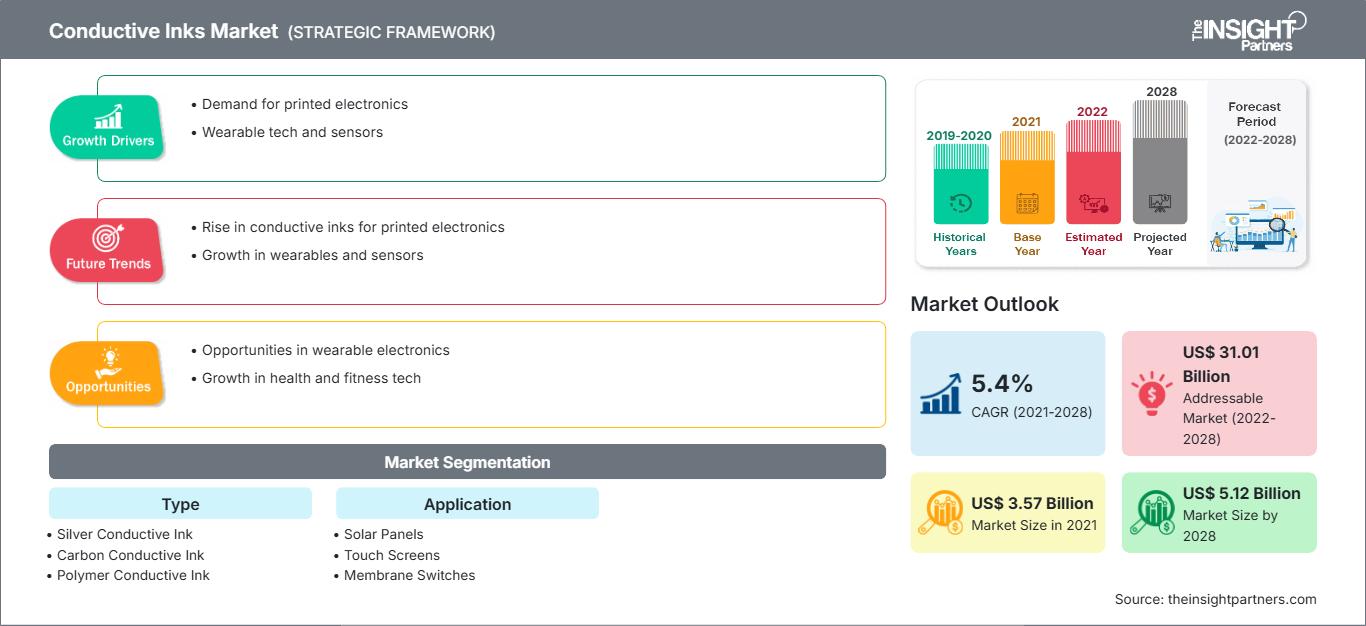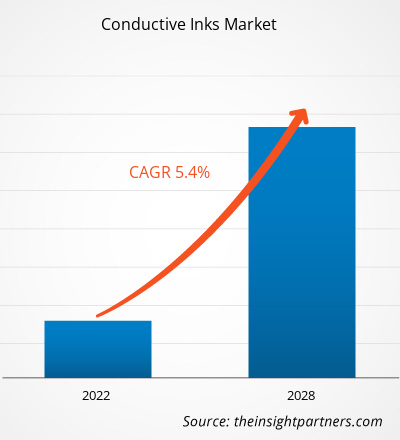[연구 보고서] 전도성 잉크 시장은 2021년 35억 6,580만 달러에서 2028년 51억 1,980만 달러로 성장할 것으로 예상되며, 2022년부터 2028년까지 연평균 5.4% 성장할 것으로 예상됩니다.
전 세계 각국 정부는 산업계가 기기의 무거운 소재를 최신 경량 소재로 대체하도록 장려하기 위해 환경 규제를 시행하고 있습니다. 또한, 작고 가벼운 전자 제품에 대한 소비자들의 요구는 가전 업계의 제품 소형화를 촉진하고 있습니다. 또한, IoT 기반 애플리케이션의 급속한 증가와 소형화 추세는 전도성 잉크 시장 수요를 견인할 것으로 예상됩니다. 스마트폰과 커넥티드 기기의 사용이 급증함에 따라 저전력 소모와 향상된 성능을 갖춘 더 작고 가벼운 센서에 대한 수요가 증가하고 있으며, 이는 소형화 수요를 촉진합니다. 중국은 글로벌 전자 제품 제조 산업의 전체 가치 사슬을 장악하고 있으며, 소형 전자 제품을 빠르게 생산하기 위한 신기술에 막대한 투자를 하고 있습니다. 따라서 스마트폰, 웨어러블 기기 및 기타 가젯의 소형화에 대한 수요가 증가하고 효율적인 전자 장치에 대한 수요가 증가하면서 전도성 잉크 시장 규모도 확대되고 있습니다.
이 보고서의 일부, 국가 수준 분석, Excel 데이터 팩을 포함하여 모든 보고서에 대한 사용자 정의를 무료로 받을 수 있을 뿐만 아니라 스타트업 및 대학을 위한 훌륭한 제안 및 할인을 이용할 수 있습니다
전도성 잉크 시장: 전략적 통찰력

-
이 보고서의 주요 주요 시장 동향을 확인하세요.이 무료 샘플에는 시장 동향부터 추정 및 예측에 이르기까지 데이터 분석이 포함됩니다.
COVID-19 팬데믹이 전도성 잉크 시장에 미치는 영향
COVID-19 팬데믹으로 인해 많은 유연 전자 및 인쇄 전자 산업이 인력 부족에 직면했습니다. RFID 태그 인쇄(현대 교통 티켓 및 자동차 앞유리 열선 장치)와 같은 인쇄 전자 응용 분야에서 전도성 잉크에 대한 수요가 전도성 잉크 시장 성장에 기여하고 있습니다. 또한 자동차 산업의 생산 감소는 시장에 부정적인 영향을 미쳤습니다. 국제자동차공업협회(OICA)에 따르면 2019년과 2020년 전 세계 자동차 판매량은 각각 91,227,182대와 78,774,320대였습니다. 전도성 잉크는 자동차 회로 및 인쇄 열선 장치, 특히 자동차 뒷유리에 적용되기 때문에 자동차 판매 감소는 시장에 부정적인 영향을 미치고 있습니다. 그러나 2021년 중반부터 석유 채굴 프로젝트가 재개되면서 전도성 잉크 시장 성장이 촉진되고 있습니다. 그러나 팬데믹 이전, 북미 지역의 자동차 산업 성장, 전기 자동차 보급률 증가, 그리고 건강에 대한 인식 제고는 기기 소형화 수요를 촉진했습니다. 가전제품 산업 또한 성장세를 보였습니다. 또한 스포츠 웨어러블 시계와 건강 모니터링을 위한 전자 의료기기와 같은 소형 경량 전자제품에 대한 수요 증가는 전도성 잉크 시장의 성장을 촉진하고 있습니다.
시장 분석 - 전도성 잉크 시장
태양광 패널 설치 증가로 전도성 잉크 시장 성장 촉진
에너지 수요 증가는 대체 에너지원 활용을 요구하고 있습니다. 따라서 재생 에너지원, 특히 태양 에너지가 발전에 사용되고 있습니다. 발전용 태양 에너지 사용량 증가는 태양광 기반 기술 수요를 견인하고 향후 태양광 패널 설치 규모를 증가시킬 것으로 예상됩니다. 이는 태양광 발전 분야에서 전도성 잉크 시장에 새로운 기회를 창출할 것입니다. 잉크젯 인쇄를 통해 전도성 잉크는 매우 얇고 유연한 표면에 인쇄된 유기 태양광 태양 전지 패널을 제작할 수 있습니다. 태양광(광전지) 분야는 기존 전력망과 경쟁하기 위해 원자재 비용 절감 및 생산 효율 향상이라는 상당한 압박을 받아 왔습니다. 이러한 상황에서 전도성 잉크는 업계의 잠재적 해결책으로, 전도성 잉크 시장을 견인하고 있습니다.
유형 기반 인사이트
전도성 잉크 시장은 유형별로 은 전도성 잉크, 탄소 전도성 잉크, 폴리머 전도성 잉크, 구리 전도성 잉크 등으로 구분됩니다. 탄소 전도성 잉크 부문은 2021년 시장 점유율 1위를 차지했습니다. 탄소 전도성 잉크는 윤활성이 뛰어나 마찰이 적고 열 안정성이 우수합니다. 이 잉크는 스크린 인쇄, 디핑, 주사기 분사에 사용되며 유리 및 다양한 기판에 대한 접착력이 뛰어납니다. 기존의 전도성 소재와 달리 탄소 잉크는 마모, 긁힘, 휘어짐, 주름에 강합니다. 인쇄 전자 분야의 급속한 성장은 전도성 잉크 개발에 기여했습니다. 탄소 기반 전도성 잉크의 전도성 필러는 공급이 풍부하고 가격이 저렴하며 안정성이 우수하고 응용 가치가 높습니다. Nanoshel LLC, Henkel, Dycotec Materials Ltd는 탄소 전도성 잉크 시장의 주요 기업입니다. 이러한 기업들의 존재는 시장 성장에 기여하고 있습니다.
전도성 잉크 시장에서 활동하는 기업들은 주로 첨단 고효율 제품 개발에 집중하고 있습니다.
- 2022년, 듀폰 마이크로회로 및 부품 소재 사업부는 의료 분야를 위한 새로운 은/염화은 전도성 잉크/페이스트인 5881 출시를 발표했습니다.
- 2021년, 듀폰은 고성능 전자파 차폐 및 열 관리 솔루션 분야의 세계적인 선두 기업인 Laird Performance Materials의 인수를 성공적으로 완료했다고 발표했습니다.
전도성 잉크 시장 지역별 통찰력
The Insight Partners의 분석가들은 예측 기간 동안 전도성 잉크 시장에 영향을 미치는 지역별 동향과 요인을 면밀히 분석했습니다. 이 섹션에서는 북미, 유럽, 아시아 태평양, 중동 및 아프리카, 그리고 중남미 지역의 전도성 잉크 시장 부문과 지역별 분포도 살펴봅니다.
전도성 잉크 시장 보고서 범위
| 보고서 속성 | 세부 |
|---|---|
| 시장 규모 2021 | US$ 3.57 Billion |
| 시장규모별 2028 | US$ 5.12 Billion |
| 글로벌 CAGR (2021 - 2028) | 5.4% |
| 이전 데이터 | 2019-2020 |
| 예측 기간 | 2022-2028 |
| 다루는 세그먼트 |
By 유형
|
| 포함된 지역 및 국가 |
북미
|
| 시장 선도 기업 및 주요 회사 프로필 |
|
전도성 잉크 시장 참여자 밀도: 비즈니스 역학에 미치는 영향 이해
전도성 잉크 시장은 소비자 선호도 변화, 기술 발전, 그리고 제품의 장점에 대한 인식 제고 등의 요인으로 인한 최종 사용자 수요 증가에 힘입어 빠르게 성장하고 있습니다. 수요가 증가함에 따라 기업들은 제품 라인을 확장하고, 소비자 니즈를 충족하기 위한 혁신을 추진하며, 새로운 트렌드를 적극 활용하고 있으며, 이는 시장 성장을 더욱 가속화하고 있습니다.

- 을 얻으세요 전도성 잉크 시장 주요 주요 플레이어 개요
전도성 잉크 시장은 유형 및 응용 분야를 기준으로 세분화됩니다. 유형별로는 은 전도성 잉크, 탄소 전도성 잉크, 폴리머 전도성 잉크, 구리 전도성 잉크 등으로 세분화됩니다. 2021년에는 탄소 전도성 잉크 부문이 시장을 주도하며 가장 큰 시장 점유율을 차지했습니다. 응용 분야별로는 태양광 패널, 터치스크린, 멤브레인 스위치, 의료 기기, 인쇄 회로 기판, 센서, 발열체, 무선 주파수 식별(RFID), 휴대폰 안테나, 자동차 등으로 세분화됩니다. 2021년에는 인쇄 회로 기판 부문이 시장을 주도하며 가장 큰 시장 점유율을 차지했습니다. 지리적으로는 북미, 유럽, 아시아 태평양(APAC), 중동 및 아프리카(MEA), 남미(SAM)로 크게 세분화됩니다. 2021년에는 APAC 지역이 글로벌 시장에서 상당한 점유율을 차지했습니다.
Applied Ink Solutions; DuPont DE Nemours, Inc.; Henkel AG 및 CO. KGAA, Inkron OY, Inktec, Heraeus, Novacentrix, POLY-INK, Merck KGAA, Vorbeck Materials Corporation은 전도성 잉크 시장에서 활동하는 주요 기업입니다.
- 과거 분석(2년), 기준 연도, CAGR을 포함한 예측(7년)
- PEST 및 SWOT 분석
- 시장 규모 가치/거래량 - 글로벌, 지역, 국가
- 산업 및 경쟁 환경
- Excel 데이터세트
최근 보고서
사용 후기
구매 이유
- 정보에 기반한 의사 결정
- 시장 역학 이해
- 경쟁 분석
- 고객 인사이트
- 시장 예측
- 위험 완화
- 전략 기획
- 투자 타당성 분석
- 신흥 시장 파악
- 마케팅 전략 강화
- 운영 효율성 향상
- 규제 동향에 발맞춰 대응






















 무료 샘플 받기 - 전도성 잉크 시장
무료 샘플 받기 - 전도성 잉크 시장